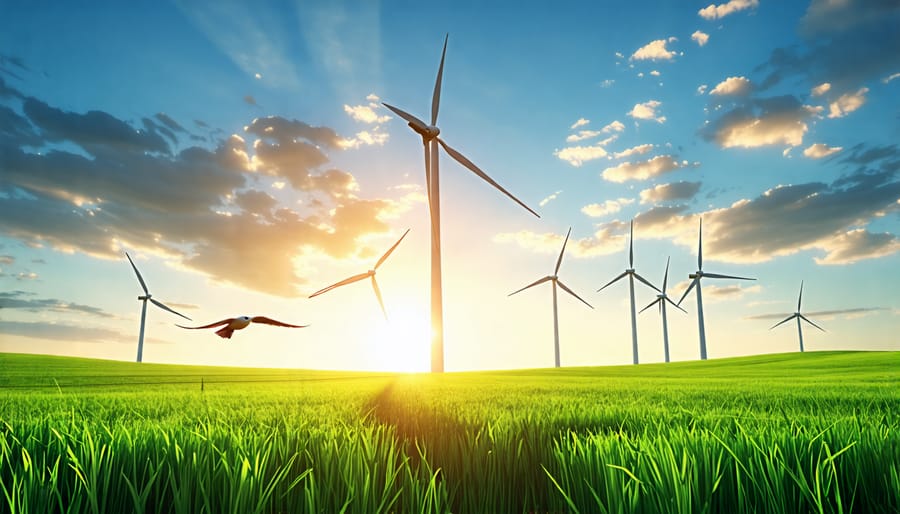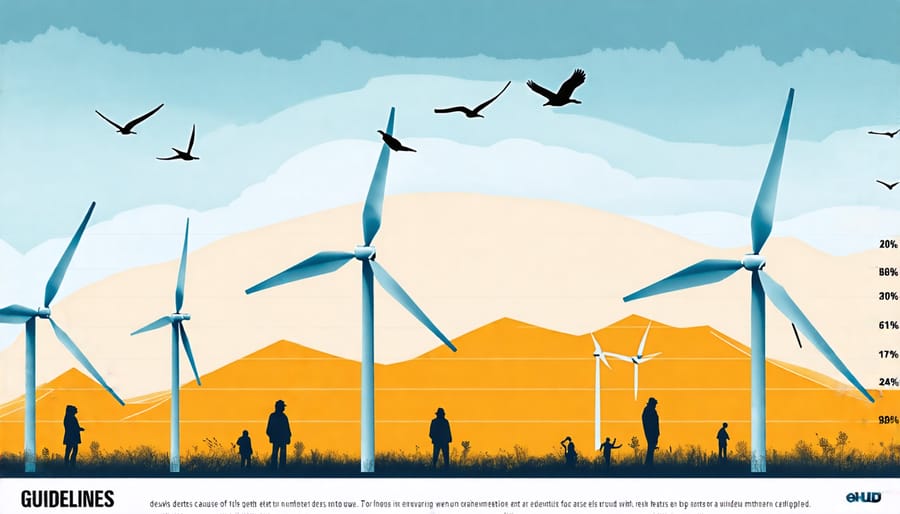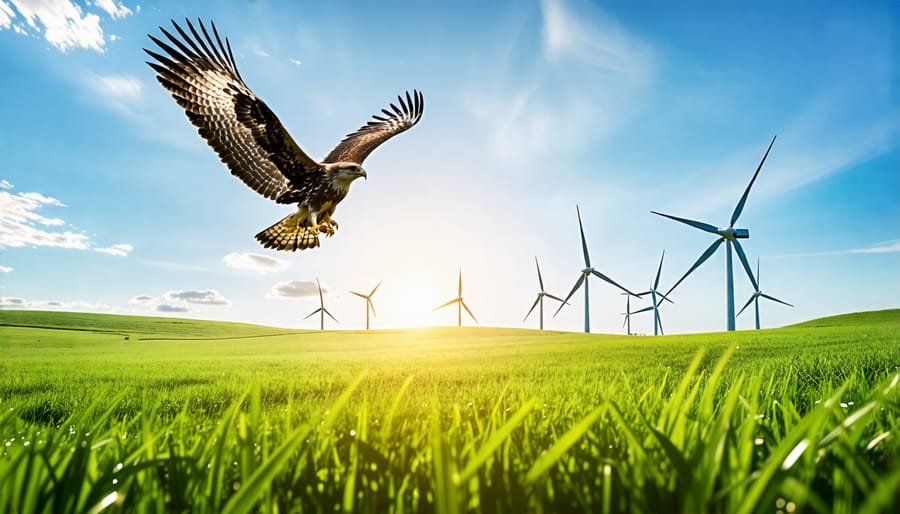As the demand for renewable energy sources like wind power grows, concerns have been raised about the unintended consequences for wildlife, particularly birds. Wind turbines, those towering icons of clean energy, have come under scrutiny for their role in avian mortality. But just how many birds fall victim to these spinning blades each year?
According to recent studies, wind turbines in the United States alone are responsible for the deaths of approximately 234,000 birds annually. While this figure may seem alarming at first glance, it’s important to place it in context. The U.S. Fish and Wildlife Service estimates that collisions with buildings, power lines, and vehicles claim hundreds of millions of avian lives each year, dwarfing the impact of wind turbines.
However, the global picture tells a more sobering story. Research suggests that wind farms worldwide could be killing as many as 681,000 birds per year. As the number of wind turbines continues to grow, driven by the urgent need to combat climate change, this toll on bird populations cannot be ignored.
But what factors contribute to bird mortality at wind farms, and what can be done to mitigate their impact? Join us as we explore this complex issue, balancing the promise of wind energy with the imperative to protect our feathered friends. Together, we’ll examine the latest research, innovative solutions, and the path forward in the quest for truly sustainable energy.

Annual Bird Mortality Estimates
U.S. Statistics
According to recent studies, wind turbines in the United States are estimated to cause between 140,000 and 500,000 bird deaths annually. While these numbers may seem significant, it’s important to put them into perspective. The U.S. Fish and Wildlife Service estimates that collisions with buildings, power lines, and vehicles kill hundreds of millions of birds each year, far surpassing the impact of wind turbines.
The majority of bird fatalities at wind farms occur during migration seasons, particularly in spring and fall. Factors such as location, weather conditions, and species behavior can influence the risk of collisions. Raptors, including hawks and eagles, are among the most vulnerable due to their flight patterns and hunting behaviors.
To address this issue, the wind energy industry has been working closely with environmental organizations and government agencies to develop strategies for reducing bird mortality. These efforts include careful site selection, advanced radar systems to detect approaching birds, and temporary turbine shutdowns during peak migration periods. Ongoing research and monitoring aim to further understand and mitigate the impact of wind turbines on avian populations, ensuring that the benefits of clean energy can be harnessed while minimizing harm to wildlife.
Global Impact
As wind energy continues to expand globally, the impact on bird populations has become a concern in many countries. In Europe, which has the highest installed wind energy capacity worldwide, it is estimated that wind turbines cause between 0.3 and 18.3 fatalities per turbine annually. Spain, Germany, and the United Kingdom, being among the top wind energy producers in Europe, have reported varying levels of bird mortality due to collisions with wind turbines.
In Asia, China and India are rapidly increasing their wind energy infrastructure. While specific data on bird fatalities in these countries is limited, studies suggest that the impact may be similar to that observed in Europe and North America. Australia, another country investing heavily in wind power, has also reported cases of bird collisions with wind turbines, particularly affecting raptor species.
Latin American countries, such as Brazil and Mexico, are also expanding their wind energy capacity. As these countries have diverse and abundant bird populations, concerns have been raised about the potential impact of wind turbines on avian fauna. However, more research is needed to quantify the extent of bird fatalities in these regions.
It is important to note that while wind turbines do contribute to bird mortality, the scale of their impact varies greatly depending on factors such as location, turbine design, and the specific bird species involved. As countries continue to develop wind energy infrastructure, implementing proper siting guidelines and mitigation measures can help minimize the negative effects on bird populations.
Factors Influencing Bird Mortality
When examining the factors that contribute to bird mortality caused by wind turbines, several key elements come into play. Turbine design is a significant aspect, with older, lattice-style towers posing a higher risk to birds compared to modern, monopole designs. The height and rotor sweep area of turbines also influence collision rates, as taller turbines with larger rotor diameters cover a greater airspace.
Location plays a crucial role in determining the impact of wind farms on bird populations. Turbines situated in migratory pathways, near wetlands, or in areas with high concentrations of birds are more likely to cause fatalities. For example, the Altamont Pass Wind Farm in California, one of the oldest wind farms in the U.S., has been associated with high bird mortality rates due to its location in a migratory pathway and the presence of numerous raptor species.
Migration patterns are another critical factor, as many bird species undertake long-distance journeys between breeding and wintering grounds. During these migrations, birds may encounter wind farms, increasing the likelihood of collisions. Nocturnal migrants, which often fly at lower altitudes, are particularly vulnerable to collisions with wind turbines.
Weather conditions can also influence bird mortality rates. Low visibility due to fog, rain, or snow can disorient birds and make it harder for them to detect and avoid turbines. Strong winds can affect birds’ flight paths and increase the risk of collisions, especially when wind direction is perpendicular to migration routes.
Prey availability near wind farms can attract predatory birds, such as raptors, increasing their exposure to turbines. Additionally, the presence of perches, such as power lines or maintenance platforms, can draw birds closer to turbines, further increasing the risk of collisions.
Mitigation Strategies

Improved Turbine Design
In recent years, significant [advancements in wind turbine technology](https://www.windforfuture.com/the-future-of-wind-turbines/) have been made to minimize bird collisions. Researchers and manufacturers have collaborated to develop innovative designs that reduce the risk to avian populations. One such advancement is the use of radar systems to detect approaching birds and temporarily shut down turbines, allowing the birds to pass safely. Additionally, the placement of wind farms is now more carefully considered, avoiding major migratory routes and critical habitats. The use of larger, slower-rotating blades has also proven effective in reducing bird strikes, as they are more visible and easier for birds to avoid. Furthermore, the painting of turbine blades with UV-reflective paint has shown promise in deterring birds, as many species can see ultraviolet light. As these advancements continue to evolve, the wind energy industry is becoming increasingly bird-friendly, ensuring a more sustainable future for both renewable energy and wildlife.
Strategic Siting
Strategic siting of wind farms is crucial in minimizing the impact on birds. By carefully selecting locations that avoid critical bird habitats and migration routes, developers can significantly reduce the risk of collisions. This involves conducting thorough environmental assessments and consulting with wildlife experts to identify areas with low bird activity. Factors such as topography, prevailing winds, and proximity to water bodies should also be considered. By placing turbines in less sensitive areas, away from known flight paths, the industry can strike a balance between renewable energy generation and bird conservation. Additionally, ongoing monitoring and adaptive management strategies can help identify and address any unforeseen issues that may arise post-construction. With a proactive and science-based approach to siting, the wind energy sector can continue to grow while minimizing its impact on avian populations.
Balancing Renewable Energy and Wildlife Conservation
Balancing renewable energy expansion with wildlife conservation is a complex challenge that requires collaboration between the wind industry and conservation groups. As the demand for clean energy grows, it is crucial to develop strategies that minimize the impact on bird populations while still achieving clean energy goals. Wind energy companies are increasingly partnering with wildlife organizations to conduct research, monitor bird activity, and implement mitigation measures such as radar detection systems and temporary turbine shutdowns during peak migration periods. By working together, these stakeholders can find innovative solutions that allow for the continued growth of wind power while protecting our feathered friends. With a combination of technological advancements, strategic siting of wind farms, and adaptive management practices, it is possible to strike a balance between renewable energy and wildlife conservation. As we move towards a more sustainable future, it is essential that we prioritize both the health of our planet and the well-being of its inhabitants, ensuring that the transition to clean energy is a win-win for all.





